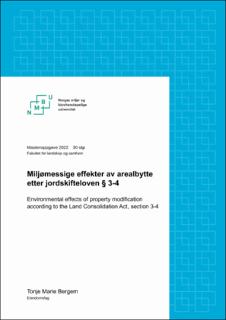| dc.contributor.advisor | Sky, Per Kåre | |
| dc.contributor.author | Bergem, Tonje Marie | |
| dc.coverage.spatial | Norway | en_US |
| dc.date.accessioned | 2022-09-26T12:44:30Z | |
| dc.date.available | 2022-09-26T12:44:30Z | |
| dc.date.issued | 2022 | |
| dc.identifier.uri | https://hdl.handle.net/11250/3021358 | |
| dc.description.abstract | Temaet for oppgaven er miljømessige effekter av jordskifte, avgrenset til effekter på lokale økosystemer og kulturlandskapet. Jordskifteretten kan omforme eiendom og alltidsvarende bruksretter etter jordskifteloven § 3-4, også omtalt som arealbytte og makebytte. Formålet med oppgaven er å beskrive noen av de overordnede effektene arealbytte etter jordskifteloven § 3-4 kan ha på de lokale økosystemene og kulturlandskapet.
Hovedproblemstillingen er: «Hvilke effekter kan arealbytte etter jordskifteloven § 3-4 ha på lokale økosystemer og kulturlandskapet?». Hovedproblemstillingen konkretiseres av to delproblemstillinger:
1) Hvilke effekter kan arealbytte etter jordskifteloven § 3-4 ha på lokale økosystemer?
2) Hvilke effekter kan arealbytte etter jordskifteloven § 3-4 ha på kulturlandskapet?
Jeg har brukt flere kvalitative metoder innenfor samfunnsvitenskapelig metode i forsøk på å belyse problemstillingene. Utgangspunktet for studien er en casestudie bestående av fem jordskiftesaker som har tatt i bruk jordskifteloven § 3-4. Jeg har brukt intervjuer av parter i jordskiftesaker, ingeniører ved jordskifteretten og jordskiftedommere som primærkilden til informasjon. Befaring, flyfoto, Gårdskart og litteratur har jeg brukt som støttekilder for å utdype informasjon fra intervjuene.
Et hovedfunn i casestudien var at arealbytte kan ha små effekter på de lokale økosystemene og kulturlandskapet. Årsaken til dette kan være at arealbytte innebærer få fysiske endringer, og arealene blir forvaltet på samme måte av nye eiere etter jordskifte. Et annet funn i flertallet av sakene, var at arealbytte kan medføre redusert transport, derav reduserte CO2-utslipp. Funnene viste også til at arealbytte kan bidra til å forhindre gjengroing av kulturlandskapet. Andre funn viste til at arealbytte kan resultere i nedbygging av ubebygd areal, tetting av grøfte, samt fjerning av randsoner og kulturlandskapselementer. Funnene indikerer også at etablering av bruksordningsregler kan bidra til bedre vedlikehold og bevaring av skog. Casestudien av de fem jordskiftesakene viste til at det er stor variasjon i effektene av jordskiftesaker etter jordskifteloven § 3-4. | en_US |
| dc.description.abstract | The theme of this thesis is environmental effects of land consolidation, limited to effects on local ecosystems and the cultural landscape. The land consolidation court can modify properties and perpetual easements according to the Land Consolidation Act, section 3-4, also referred to as land exchange cases. This thesis aims to describe some of the effects these cases can have on local ecosystems and the cultural landscape.
The main research-question is: “What effects can property modification according to the Land Consolidation Act section 3-4 apply to the local ecosystems and the cultural landscape?”. I have made the following two research questions to answer main research question:
1) What effects can property modification according to the Land Consolidation Act, section 3-4 apply to the local ecosystems?
2) What effects can property modification according to the Land Consolidation Act, section 3-4 apply to the cultural landscape?
I have used several qualitative methods within social science in this research. The research is based on a case study consisting of five land consolidation cases according to the Land Consolidation Act, section 3-4. Interviews of judges and engineers at the land consolidation court, plus parties in the cases are the main data in this research. I have used inspection of the land consolidation areas, aerial photos, Farm Maps (Gårdskart) and literature to support and elaborate the data from the interviews.
A main finding in the case study was that property modification may not have considerable effects on the local ecosystems and the cultural landscape. The reason for this can be that the property modification can involve few physical changes, and the properties can be managed in the same way by the new owners when the case is closed. Another key finding was that property modification can result in reduced transport, hence reduced emissions of CO2. The findings also indicate that property modification can result in less resource intensive maintenance of the cultural landscape. Other findings indicated that property modification can lead to removal of border zones and cultural elements, building on undeveloped land and ditches being sealed. The findings also indicate that the usage scheme made by the land consolidation court for a common area can result in conservation and better maintenance of forest land. The findings showed that there was great variation between cases according to the Land Consolidation Act section 3-4. | en_US |
| dc.language.iso | nob | en_US |
| dc.publisher | Norwegian University of Life Sciences, Ås | en_US |
| dc.rights | Attribution-NonCommercial-NoDerivatives 4.0 Internasjonal | * |
| dc.rights.uri | http://creativecommons.org/licenses/by-nc-nd/4.0/deed.no | * |
| dc.title | Miljømessige effekter av arealbytte etter jordskifteloven § 3-4 | en_US |
| dc.title.alternative | Environmental effects of property modification according to the Land Consolidation Act, section 3-4 | en_US |
| dc.type | Master thesis | en_US |
| dc.description.localcode | M-EIE | en_US |

